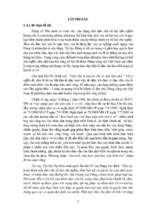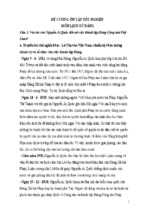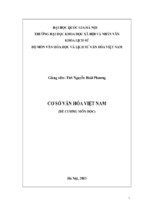1
2
SUMMARY OF THE THESIS
effect of education or health on economic growth, how to examine the interaction of these
two factors on economic growth is still a question. reply. Therefore, it is necessary to
systematically study the effects of education and health on Vietnam's economic growth
process, for a period long enough by quantitative models, the results will allow
assessment. correctly and fully the role of health and education in economic growth in
Vietnam. An in-depth look at the constituents and indicators used as a measure in the field
of health and education will allow the author to make specific proposals that are highly
feasible.
Therefore, the topic that the PhD candidate will propose in this research plan is
"Examining the effect of education and health along with the interaction between these
two factors on the process of economic growth in Vietnam with The data was collected in
the period from 2011 to 2016 ”.
2. Research objectives
The main objective of the thesis is to study the influence of two main factors that
make up human capital: education and health; their interaction effects on Vietnam's
economic growth, thereby making recommendations on education and health policy to
help drive growth.
To accomplish this goal, the thesis answers the following research questions:
(1) How does education affect economic growth, the difference between the effect
of public expenditures on education on economic growth and the effect of private
expenditures on education on economic growth?
(2) How does health affect economic growth, the difference between the effect of
public expenditures on health on economic growth and the effect of private expenditures
on health on economic growth?
(3) What is the effect of education-health interaction on economic growth?
3. Research subject and scope
Research subjects: The effect of education, health and their interaction on
economic growth.
Research scope: Research space: Provinces / cities throughout Vietnam.
Study period: From 2011 to 2016
4. Research Methodology
- Method of document review: Inheriting existing documents, including legal documents
and policies; Published books, documents, analysis reports, domestic and foreign research
related to the research topic.
- Methods of synthesis, comparison, statistics and description: to assess the reality of
education, health, economic growth, and at the same time clarify the reality of the
relationship between private expenditures and expenditure Public expenditures on
education and health expenditures on economic growth.
- Quantitative analysis method: The thesis uses a number of econometric models to
analyze the effect of education, health and their interaction on Vietnam's economic
growth; using quantitative models to clarify the difference between private expenditures
and public expenditures on education and health on economic growth. The effectiveness of
expenditures is measured by the sign and magnitude of the estimated coefficients of health
and education expenditures in the private and public expenditure models. The coefficients
of the model are estimated as follows:
1. Reason to choose a topic
Maintaining a reasonable economic growth rate for the country's prosperity and
prosperity is something that every country in the world pursues. Economic growth is
expressed by the country's actual income rate. Economic growth has spurred job creation,
improved income and rapid poverty reduction. However, not all economic growth is
effective for the country, if the economic growth is excessive or too high, the people will
be rich, but its dark side will lead to inflation, rich and poor division. in society increased.
Experiencing changes in the renovation process since 1986, Vietnam has achieved
remarkable achievements, the average annual economic growth rate in the period of 20042016 is 6.35%; GDP at current prices in 2014 was 5.5 times more than in 2004; Vietnam
has been a low-middle-income country since 2010. But Vietnam still faces challenges and
difficulties, recent research results show many signs of economic growth. However, the
competitiveness and efficiency of investment in the economy have decreased. Therefore,
the country is required in each period to find positive measures to achieve rational and
sustainable growth. In particular, researchers and policy makers recognize that, after a
period of rapid growth based on physical capital accumulation, the country needs to start
looking for other economic growth models and modes, more emphasis on capital
accumulation, labor and people. Gross domestic product (GDP) in 2012 grew by only
5.03%, at the same time many businesses dissolved, stopped operating, growing sharply,
much more serious than the number of unemployed workers. The growth rate is low,
showing that the business environment in Vietnam is getting worse and the quality of
factors affecting economic growth needs to be revised.
In fact, the economic development process of many countries in the world has
shown the importance of human capital. Japan is a country that is poor in mineral
resources, which was devastated by nature and war, but the rise and development of Japan
was a storm, or the rapid economic recovery of the nations. Western Europe relies on high
quality human resources, not resources. Although developing countries have many
resources but lack quality labor, the economic growth process is very slow (Waines,
1963).
There are many factors that directly affect a country's growth, but recent studies
have shown that "education and health are the two key factors." Evidence from the
development of East Asian tigers shows that a strong education and a modern health
system is an important driving force for the nation's economic growth and prosperity.
(World Bank, 1993). Besides health and education, a country's growth process is
influenced by many other factors and the interaction between these factors in an
institution. Factors such as political and institutional factors, environmental and
geographical factors, culture, history, the degree of openness of the economy to foreign
investment, employers' policies to improve productivity, macroeconomic management
policies and external environmental effects.
In Vietnam, there have been many studies on the growth process and the factors
affecting the growth process. These studies often focus more on economic factors but have
not yet considered social factors. In this study, the author will focus on two factors: health
and education along with the interaction of these two factors to the process of economic
growth in Vietnam from 2011 to 2016. Wearing Although these studies have shown the
3
4
Cross-data regression (OLS): Expenditures on education or health in a year may not
create human capital immediately to effect economic growth, so the cross-sectional
data model is aimed at look at the average of factors that create human capital in the
period of 2011-2016 affecting Vietnam's economic growth.
Panel data model: use the Generalized Method of Moment (GMM) to solve
endogenous variables for panel data model.
Data sources
- The data used in the study includes data collected from the General Statistics Office and
the Statistics Departments of provinces and cities from 2011-2016 in statistics by 63
provinces.
- Other macro data of Vietnam for the period of 2011-2016 are provided by the General
Statistics Office.
- The figures for public education and health expenditures are extracted from the Ministry
of Finance
- Survey data on provincial competitiveness (PCI) provided by Vietnam Chamber of
Commerce and Industry (VCCI); Data on Provincial Governance and Public
Administration Performance Index (PAPI)
- Data on the living standard survey (VHLSS) 2010-2016
5. Scientific and practical significance
The thesis uses mainly quantitative research methods, with econometric models that
are fully tested to ensure high reliability to solve a number of important scientific issues of
theory. and practical as follows:
Theoretically: The thesis combines estimation methods to analyze the effect of
private expenditures (on health and education) and public expenditures on economic
growth.
In practice:
- Clearly distinguish the effect of private expenditures on health and education on
economic growth compared to the efficiency of public expenditures on health and
education on economic growth.
- Clarify the ineffectiveness of public expenditures on health and education compared to
the corresponding expenditures of households on economic growth.
- Assess the effect of the interaction of education and health on economic growth at public
and private expenditures, through interaction coefficients - Research results of the thesis is
the basis for proposing a number of policy recommendations to improve the efficiency of
public expenditures on education and health as well as encourage the development of
private human resources in the direction of promoting economic growth in Vietnam.
6. The structure of the thesis:
The layout of the thesis consists of 4 chapters:
Chapter 1: Rationale and research overview
Chapter 2: Current situation of education, health and economic growth in Vietnam for the
period of 2011-2016
Chapter 3: The model analyzes the effect of education, health and their interaction on
Vietnam's economic growth
Chapter 4: Conclusions and Recommendations.
CHAPTER 1
RATIONALE AND RESEARCH OVERVIEW
1.1. Theoretical basis of the role of human capital in economic growth
The thesis is researched on the basis of economic growth theory, in which human
capital plays an important role for economic growth.
1.1.1 Classic growth model
Economic growth was discussed by classical economists Adam Smith and David
Ricardo from the late 17th and early 18th centuries, but it was not until the mid-20th
century that economic growth was studied by scientists. basically. Along with that process,
economic growth theories have also been increasingly improved to clarify the theoretical
and practical issues posed in economic life. Studying the origin of economic growth, the
scientists divided growth factors into two groups: exogenous and endogenous.
1.1.2 Neoclassical growth model
In the 1960s, growth theory consisted mainly of neoclassical models, such as
Ramsey (1928), Solow (1956), Swan (1956), Cass (1965). One characteristic of this model
is that the property is convergent. The lower the starting level of GDP per capita (GDP),
the higher the forecast growth rate. Education has been the focus of interest for economists
in studying economic growth since the endogenous growth tissues were introduced. In the
1950s, the Solow-Swan growth model included labor as an incremental production factor
and technological progress as exogenous variable over time, the determinants of growth. in
the long run (Solow 1957), increasing human capital will increase labor productivity,
leading to higher income levels (Schultz 1961). This problem was supported by
economists who concurred with Schultz's theory of human capital theory (Blaug 1976).
1.1.3. Endogenous growth theory
In the 1980s, the endogenous growth theory was introduced by Romer to overcome
the constraints identified in the neoclassical Swan-Solow growth tissue (Romer 1986).
This theoretical framework highlights the important role of human resource research and
development, including education, as a mechanism for the accumulation of technological
knowledge.
1.2 Concepts and measurement of education, health, economic growth
1.2.1 Definition and measurement of Education
1.2.1.1 Concept of Education
Since its inception, education has become one of the basic factors promoting socioeconomic development through the implementation of the social function of education.
The concepts of education can be understood as follows:
According to Dewey, John (1944) Education is understood as a form of learning whereby
the knowledge, skills, and habits of a group of people are transferred from generation to
generation through teaching, training, or research. Education usually takes place under the
guidance of others, but can also be through self-study
1.2.1.2 Education Measurement
Many researchers have measured education in different ways, but the most common is
indirect indirect measurement.
According to the direct measure, Education is measured by the enrollment rate, the
average number of years of schooling, the enrollment rate at all levels, the percentage of
university graduates, the rate of vocational training ...
On the indirect measure, Education is measured by expenditures on education
5
6
Educational expenditures cover all financial resources used to mobilize the human and
material resources necessary for the operation of the educational system, Education
expenditures include:
- Public expenditures (government) for the human and material inputs needed to provide
educational services
- Private expenditures from students and families
- Social expenditures from the whole community
1.2.2 Definition and measurement of Health
1.2.2.1 Definition of Health
According to the World Health Organization (WHO): health or health care is the
diagnosis, treatment and prevention of diseases, illnesses, injuries, and other physical and
mental impairments in humans. . Health care varies among countries, groups and
individuals, largely influenced by social and economic conditions as well as on-site health
policies. Health care systems are organizations that are established to meet the health
needs of the population. Household health expenditure is the total amount of money a
household has to spend on all health-related items, including disease prevention, health
promotion and medical examination and treatment. Household expenditures may be
payments made before illness (for example, purchase of health insurance) or out-of-pocket
payments when using the service.
1.2.2.2 Health Measurement
As with education, health is also measured in a direct and indirect way.
According to direct measurement, Health is measured by: birth rate, death rate, average
life expectancy, quality of health care ...
In an indirect measure, Health is measured by Health expenditures, the total national
health expenditure represents the total social expenditure for health, which is made up of
two main expenditure categories: public expenditure and public expenditure. private for
health.
Total national health expenditure = Public expenditure on health + Private
expenditure on health
Public Health Expenditure: Put simply: when a service is paid for by tax revenues
from the state, or from the social health insurance fund, or from ODA (publicly
coordinated), That expenditure is called the public expenditure.
Public expenditures = state budget expenditures on health (excluding state budget
allocations through health insurance) + social health insurance fund + ODA
Private expenditures on Health
Expenditures: paid by individuals or households directly to the service provider
when they are sick and use the service, when they buy medicines and health-related
supplies and equipment. With such a concept, hospital fees and co-payments (when
medical care is covered by health insurance) are paid directly out-of-pocket by patients,
whether collected in public or private hospitals, which are private expenditures.
Private expenditure = direct expenditure of households + expenditures by charities
and enterprises (excluding corporate contributions to social health insurance) + private
health insurance
Direct out-of-pocket expenditures on health
1.2.3. Concept and measurement of economic growth
1.2.3.1 Definition of economic growth
The concept of economic growth first appeared in Adam Smith's Wealth of Nations,
published in 1776, and in 1956 in the article A contribution to the theory of economic
growth. Robert Solow's economics has fully explained this concept. Until now, the
concept of economic growth has been developed and increasingly improved, most
economists have agreed that: economic growth is the increase of gross national product in
a period of time. This is the result of all production activities and services created by the
economy, regardless of whether those activities are performed domestically or abroad.
1.2.3.2 Measurement of economic growth
The average annual growth of a Country is usually measured as follows:
ggdpt = GDPt / GDPt-1,
where: GDP is the average income per capita, t is the time of year to be surveyed
However, this calculation only shows the growth rate of the following year compared to
the previous year. Therefore, many countries in the world measure economic growth
through GDP, a measure of annual social production, used to compare internationally in
terms of the volume of economic development levels among countries, Countries with
market economies still often use two types of aggregate economic indicators: Gross
National Product (Gross National Product, abbreviated to GNP), Gross Domestic Product
(Gross Domestic Product, abbreviated as GDP).
Methods of measuring GDP
Currently in Vietnam, the General Statistics Office calculates GDP according to
three methods: expenditure method, income method and production method.
Expenditure method: This method measures GDP by collecting data on
consumption expenditure (C), investment (I), government expenditures on goods and
services (G), and exports. net (NX).
Income method: This method calculates GDP according to the cost of production
inputs that businesses must pay, interest payments, factory rentals, assets, wages, salaries
and profits earned when participating in business, collected to compensate for the value of
machinery, equipment and fixed assets worn down during the production process.
Production method (value-added method): According to the value-added method,
GDP is gathered all the added values of enterprises in the production process, usually one
year.
Value added is the difference between the output value of an enterprise and the
purchase of raw materials purchased from other businesses that are used up in the
production process of that product.
1.3. Several factors affect economic growth
1.3.1. The effect of education on economic growth
The importance of education to economic growth through increasing labor productivity
1.3.2 The effect of health on economic growth
Health is a solid foundation for economic development, one of the keys to economic
efficiency determinants at both micro and macro levels, contributing to the process of
economic growth. This is also derived from studies of Blomm & Canning (2003),
Grossman (1972) that health is a direct component of human life and a form of increasing
personal development, communication thereby affecting socio-economic growth. Some
researchers have the same opinion
7
8
Lucas (1988), Rebelo (1991), Caballe and Santos (1993), Mulligan and Sala-i-Martin
(1993), and Barro and Salai-Martin (1995a, Pikbest), Nelson and Phelps (1966), Benhabib
and Spiegel (1994)), Robert J. Barro (2013) effectively analyzed to expand the
neoclassical growth model - to incorporate the capital concept of health. A key point of
this analysis is a two-way combination of health and economy.
1.3.3 The interaction effect of education and health on economic growth
Regarding the channel of the effect of good health on education, Schultz (1961), education
and health are the two main components of the human capital component that have a direct
effect on labor quality and economic growth. In addition, theoretical channels suggest that
improving health leads to raising awareness of education throughout the life of every
human being. Romer (1986), Lucas (1988), Squire (1993), Schultz (1999), Bassanini and
Scarpetta (2001), Churchill et al (2015). Bloom (2005), Yin-Chi Wang (2011) suggest that
besides expenditures on education and health are two complementary factors, the increase
in health expenditures can contribute to improving the effect on growth. economic, leading
to increased educational efficiency and improved human capital; Therefore, public
expenditures on education and health should be combined to positively effect human
resources and economic growth.
1.3.4 Several other factors affecting economic growth
Neoclassical models have shown the important role of human capital in economic
growth, but the models also show that some other factors also have direct effects on
individual workers. and economic growth.
The effect of wages and income on economic growth
The effect of investment capital on economic growth
The effect of employment on economic growth
The influence of the institutional environment on economic growth
1.4. Research overview on the effect of education, health and their interaction
on economic growth
1.4.1. Research overview of the effect of education on economic growth
According to the first school
direct measures of education variables can be measured by the enrollment rate, the
average number of years of schooling, the enrollment rate at all levels, the percentage of
university graduates, the rate of vocational training of some studies namely: Mankiw et al
(1992, Lee (2000), Lin (2004), Kwach and Lee (2006), Cooray (2012), Khattak and Khan
(2012a), Omojimite and Ben (2010), Sawami Matsushita and et al (2006)
According to the second school
Indirect measure, education variable is measured by expenditures on education, in
education expenditures includes 2 component variables: public expenditure on education,
household expenditure on education, some researchers Research has demonstrated such as:
Yousra Mekdad et al (2014), Kouton and Jeffrey (2018), Salwa Trabelsi (2017), Mallick et
al (2016), Elumah Lucas O and Shobayo Peter B. (2017), Barro and Sala-i-Martin (1995),
Mankiw et al (1992), Barro (1991), Zeynep Karaçor et al (2017)
In addition to the direct effect, education also indirectly effects on economic growth
through its additions to other growth factors. Notably, there are studies that affect
economic growth through its addition to transparency: Kwack and Lee (2006), Pyo (1995);
Kang (2006). In recent years in Vietnam: there has also been some empirical research
analyzing the role of education in growth. The studies focus on explaining Vietnam's
growth experience in recent years, based on socio-economic variables including human
capital (Scott and Truong Thi Kim Chuyen (2004), Klump and Nguyen Thi Tue Anh
(2004)), Moock et al (1998), Nguyen Nguyet Nga (2002), Nguyen Duc Thanh (2004),
Wolff (2000), Bils and Klenow (2000), Tran Tho Dat and Do Tuyet Nhung (2008) ),
Nguyen Ngoc Hung and Tong Thi Loc (2017), Ngo Thai Hung (2015), Bui Quang Binh
(2012)
1.4.2. Overview of research on the effect of health on economic growth
According to the school of direct measurement Health
The direct measure of medical variables is measured by: birth rate, death rate,
average life expectancy, quality of health care, a number of studies including Bloom et al.
(2004), Daron Acemoglu and Simon Johnson (2007), Naeem akram et al (2008), Usman et
al (2015)
Follow the school of indirect measurement Health
Indirect measure, health variable is measured by health expenditure, total national
health expenditure represents the total social expenditure for health, which is made up of
two component variables: public expenditure on health However, some studies such as
Piabuo and Tieguhong (2017), Eugene Kouassi et al. (2018), Zahramila Elmi and Somaye.
Sadeghi (2012), Marta (2011), Ozturk and Topçu (2014), Atılgan, Kılıç and Ertuğrul
(2017)
However, there are some studies that conclude that public expenditures on human
resources has no significant effect on growth such as Maku (2009), Cetin and Ecevit
(2010), Juste Somé et al (2019). )
In Vietnam, there have been very few studies on the effects of health and health care
on the process of economic growth. Often, health and health issues affecting economic
growth are studied through indirect effects channels or interaction effects with other
factors. This can be considered as a research gap that in this study the author wants to
delve into by using quantitative models with array data sets. Some specific studies on the
effect of health on economic growth: Vu Trinh The Quan (2015), Nguyen Quang Trung
and Tran Pham Khanh Toan (2014), Nguyen Dinh Tuan (2013) Nguyen Dinh Tuan (2013)
, Nguyen Thi Thu Huong (2009), Dam Viet Cuong (2006)
1.4.3. Overview of the interaction effects of education and health on economic
growth
Measuring the interaction effect of Education and Health includes 2 variables:
Public expenditure on education and Household expenditure on education; Public
expenditures on health and household expenditures on health A number of studies can be
mentioned such as: Hongyi Li and Huang Liang (2010), Sergio Beraldo (2003), Azam and
Ahmed (2010), Tang & Lai (2011), Bloom et al (2001), Jude Eggoh et al (2015),
Awaworyi et al (2015), Hüseyin en et al (2015), Selsah Pasali (2019), Yin-Chi Wang
(2011) ), Bloom (2005), Isola and Alani (2005), However Grossman (1972), Hassan and
Kalim (2012)
In Vietnam, there are a number of simultaneous studies on the two factors
Education and Health on economic growth, however, the studies are not separated and in
depth, and these two factors, often only consider it in relation to System to increase the
9
10
quality of human resources such as Nguyen Quang Trung and Tran Pham Khanh Toan
(2014), Nguyen Ngoc Hung (2016)
1.5. Analytical framework of the thesis
Postgraduate proposed the following research model:
expenditure represents the total social expenditure of health, which is made up of two
component variables: public expenditure on health, expenditure household for health
- Interactive variable, including 2 variables: Public expenditure on education and
Household expenditure on education; Public expenditures on health and household
expenditures on health
- Control variables: Capital, Employment, Institutional Environment (Participation of
people at grassroots level; Control of corruption in public sector; Supply of public services
- Public administrative procedures; Legal conditions )
The thesis presents the research hypotheses:
H1: Education has a positive effect on economic growth
H2: There is a difference in the effect of private expenditures on education on
economic growth and the effect of public expenditures on education on economic growth.
H3: Health has a positive effect on economic growth
H4: There is a difference in the effects of private expenditures on health on
economic growth and the effects of public expenditures on health on economic growth.
H5: The effect of health on growth depends on the level of education (Education
and Health Interactions have an effect on economic growth) and vice versa
This model is only a general model, reflecting the effect of independent variables on the
dependent variable in general. The specific effect relationship over time will be shown by
the specific research models in chapter 3: empirical research model.
Comment
Chapter 1, the author has introduced the theoretical basis and overview of studies on: (i)
the theory of the effects of education on economic growth; (ii) the theory of health effects
on economic growth; (iii) The theory that affects the interaction of education and health on
economic growth. There are many studies showing that education, health and interaction
affect economic growth in the short and long term, but some studies have found no
evidence of the influence of these factors. to economic growth.
Through the review, studies on the interactive effect of education and health on economic
growth in Vietnam are also limited and inadequate, and most studies emphasize the view
that human capital people are a function of total expenditures on education and health and
define public expenditures as a determinant of human capital, or to consider one of two
factors for health or education. Most of the domestic studies use qualitative analysis
methods or if a model is stopped, there is no in-depth study of the interaction of these two
factors on economic growth. Differences in that approach, so in this thesis, the author
considers both health and education expenditures affecting economic growth. The author
has chosen to use quantitative methods, and a number of methods to estimate variables:
methods to estimate array data; General GMM moment estimation methodology, select
variables that are suitable for the scope of the study and collected macroeconomic data,
variables that can be used to measure such as: public expenditure on education ; private
expenditures on education; rate of trained labor; the rate of labor with certificate, public
expenditures on health; Private expenditures on health; average life expectancy, a number
of control factors: capital; labor; job; institutional environment
CHAPTER 2
CURRENT SITUATION OF EDUCATION, HEALTH AND ECONOMIC
GROWTH IN VIETNAM FOR THE PERIOD 2011-2016
Edu
(He)
Cap
(K)
Economic
growth (GDP)
Influence educational and
Labor
(employment)
medical interactions
Health
(Hh)
Institutional environment:
- Participation of people at grassroots level;
- Control corruption in the public sector
- Public service delivery - Public administrative
procedures
- Legal conditions
- PCI
Figure 1.1: Official research model
Source: Author's proposal
Research models
General model:
Inside:
tangtruongkinhte = β 0 + β1 giaoduc + β 2 yte + β 3 giaoduc * yte + β 4bienkiemsoat + ε
- Tangtruongkinhte: Income per capita (GDP); giaoduc: Education; yte: Health;
bienkiemsoat: other factors affecting economic growth; - β 0 ; β1 ; β 2 ; β3 ; β 4 ; ε are
constants
Variables of the model:
- Dependent variable: Economic growth, measured in per capita income (GDP)
- Education variable consists of 2 measures, (i) direct measure of educational variable that
can be measured by the enrollment rate, the average number of years attending school, the
enrollment rate at all levels, the percentage of graduates university, vocational training rate
... (ii) Indirect measure, education variable is measured by expenditures on education, in
expenditures on education includes 2 component variables: public expenditure on
education, expenditure Household consumption for education
- Medical variables include 2 measures, (i) direct measures of medical variables are
measured by: birth rate, death rate, average life expectancy, quality of health care ... (ii)
Indirect measure , health variable is measured by health expenditure, total national health
11
12
2.1. Some policies on Education and Health
2.1.1 A number of education and training policies in Vietnam took effect between
2011 and 2016
- The policy on multi-dimensional view of perception of the role of education - Policies to ensure balanced development of the education system from the State:
- Investment policies for education and training.
2.1.2 A number of policies related to medical examination and treatment in
Vietnam take effect between 2011 and 2016
- Financial policy
- Policies on medical examination and treatment for the poor (Decision 139/2002 / QDTTg amended in 2012)
- Expanded policy on payment of health insurance costs for people living with HIV / AIDS
- Policy on professional support
- Policies related to medical examination and treatment with health insurance (HI)
- Budget allocation policy
2.1.3. Policies to allocate state budget recurrent expenditures on Education and Health
2.2. The reality of education period 2011-2016
2.2.1. The reality of general education
The education sector in general, especially general education, is increasingly deeply
concerned by the whole society, especially the viewpoint of universal education in our
country today. Therefore, investment in the education sector in terms of facilities, schools,
and teachers has been improved.
- Regarding the number of schools:
According to the General Statistics Office, between 2011 and 2017, the number of
universal schools
- Regarding the number of teachers and students:
+) Number of teachers:
+) Number of high school students
2.2.2. The reality of higher education
Higher education, especially college and university education, is still a major concern of
the entire society, especially for seniors and their parents. The following table shows the
school size; teachers and students study over the years.
About school number:
Regarding the number of teachers and students:
2.2.3. The reality of vocational education
Vocational education activities can only be highly effective when the state management of
vocational training institutions is referred to one focal point, ensuring consistency and
uniformity. Therefore, in the Resolution No. 76 / NQ-CP of September 3, 2016, the
Government agreed to assign the Ministry of Labor, War Invalids and Social Affairs to be
the state management agency of vocational education. The Ministry of Education and
Training is the state management agency for pedagogical schools.
- By type of vocational education institution
- By socio-economic area
- In the form of ownership
The Law on Vocational Education stipulates that there are 3 types of ownership of
vocational training institutions including: public vocational education institutions, private
vocational education institutions and invested capital vocational training institutions.
foreign investment.
- Vocational education institutions of enterprises
- Actual situation of pupils and apprentices
+) The enrollment of vocational colleges, secondary vocational schools, primary
vocational and vocational training less than 3 months increased compared to 2015
+) Graduation information
+) Graduation results of vocational colleges, secondary vocational schools, vocational
secondary schools and vocational training less than 3 months divided by socio-economic
region
2.3. Current situation of expenditures on education
2.3.1. Situation of public expenditures on education
In general, average public expenditure on education tends to increase year by year between
2011 and 2015 in all economic growth groups. In particular, there is the greatest increase
in the two lowest growth groups and the highest growth. Accordingly, the average public
expenditure on education in the lowest growth group increased steadily from 0.45 million
VND / person / year in 2011 to 0.60 million VND / person / year in 2015. Meanwhile , a
stronger increase in the highest growth group, from VND 0.35 million / person / year in
2011 to VND 0.60 million / person / year in the following year and reaching 0 , 85 million
VND / person / year in 2015. It shows that there is a significant difference between the
average public expenditure on education among the provinces with the highest GDP
growth rates and those with the highest growth is among the lowest. However, the
difference in the average level of public expenditure on education is not clear in the
provinces of intermediate growth groups such as low growth group, medium growth group
and high growth group. From this, it can be hypothesized that a positive correlation exists
between average public expenditure on education and economic growth over the years in
the survey period.
2.3.2 Current state of private expenditures on education
By income quintile, the richer the household is, the higher the level of education
expenditures, as of 2016, the average expenditure per person per month was 1.14 million,
while per capita expenditure on education the richest (2.2 million dong / person / month) is
4 times higher than the poorest group (0.49 million dong / person / year) and more than 2
times the average rate. However, the proportion of expenditure on education in total
household expenditure is very low, only about 2% of total household expenditure.
2.4. Health situation in the period of 2011-2016
2.5. Situation of expenditures on health
2.5.1. Situation of public expenditures on health
Two major public financial flows to provide financing for health in Vietnam are the state
budget capital and the social health insurance fund. Because private investment is often
profit-driven, the Government has affirmed that it will continue to increase the budget for
health in order to achieve equity and efficiency in the health sector.
2.5.2. Situation of private expenditures on health
13
14
A study from the 2012 Vietnam Living Standards Survey shows that expenditures
on health care per capita increased significantly in 2016 compared to 2010, and it took
place fairly evenly across all income groups.
Most people in the poorest quintile are households in rural areas and the average
expenditure on health of this group increased rapidly in the period of 2010-2016. The
average health care is VND 253.6 thousand / person / year and by 2016, this figure is
VND 835.8 thousand / person / month, more than tripling compared to 2010. By 2016, the
expenditures level The average health expenditure per person per month is VND 1.36
million, while per capita expenditure on education in the richest quintile (VND 1.9 million
/ person / month) is more than 2 times higher than in the poorest quintile. (VND 0.83
million / person / year) and more than 1.5 times the average rate.
2.6. Status of economic growth
Period of 2011-2016: Vietnam's economy faced many difficulties due to internal
problems of the economy and was significantly affected by the global economic recession.
During the two years 2011-2012, economic growth continued to decline, from 6.42% in
2010 to 6.24% in 2011 and 5.25% in 2012.
From 2013 up to now, with efforts to manage policies, remove difficulties for the
economy and thanks to the positive effects of the world economic recovery, the domestic
economy has started to improve. especially recorded a breakthrough growth in 2015,
estimated at 6.68%, exceeding 0.48 percentage points compared to the plan.
2.7 The reality of economic growth expenditures on health and education
From year to year, the average household expenditure on health and education appears to
be fluctuating in a narrow range with economic growth. Specifically, the data points for
these relationships are centered around the moving average parallel to the economic
growth axis. That means, a sharp fluctuation of the average expenditures on education and
health of the household only makes a small change in the GDP growth rate of the country.
Similarly, according to the economic growth quintile, the scatter plot of public
expenditure as well as average household expenditure on health and education with
economic growth shows a spherical distribution, whether or not there exists a linear
distribution of the relationship between expenditures levels on economic growth in the 5
economic growth groups during the survey period.
As a whole, for the data set during the survey period, a positive linear relationship
exists between household expenditures on health and education on economic growth.
Comment
In chapter 2, through a comprehensive analysis and comparison of the current situation of
education and training, health, the author has found a number of factors such as average
life expectancy, percentage of trained workers, Student ratio, university / population ratio,
number of doctors per ten thousand people are factors related to labor productivity, so how
do these factors affect economic growth?
In addition, through the data set compiled from GSO in the survey period from 2011 to
2015, it is initially possible to determine a positive correlation between public
expenditures as well as average household expenditure for health, education with
economic growth. However, this correlation is relatively small. Statistical results through
graphs show a clear pattern of educational expenditures year by year and between
economic growth groups. These issues will be clarified in turn in chapter 3.
CHAPTER 3
ANALYSIS MODEL AFFECTING THE EFFECTS OF EDUCATION, HEALTH
AND THE INTERACTION OF THEIR ECONOMIC GROWTH IN VIETNAM
3.1. Data, variables used in the model
3.1.1 Usage data
Data used in the study include data collected from the General Statistics Office and the
Ministry of Finance for the years 2011-2016, statistic based on 63 provinces and cities
including information on: GDP, capital, labor, expenditure expenditures on teachers,
expenditures on health. There are also some other data used in the model as a control
variable including: data on provincial competitiveness index made by Vietnam Chamber
of Commerce and Industry; Data on Provincial Governance and Public Administration
Performance Index in Vietnam, Viet Nam Living Standards Survey (VHLSS) 2011-2016
3.1.2. Variables
From the research review and analysis of the current situation of education and health, the
author has selected the variables used in econometric models to measure for education and
health, economic growth, including Two groups: dependent variables and independent
variables. First, the dependent variable (GDP) is the province's annual gross product.
The independent variables are divided into 3 groups of factors: (i) education variables, (ii)
health variables, (iii) control variables. Specifically:
(i) Variable groups for education include the variables:
- Public expenditures on education
- Private expenditures on education is the sum of private expenditures on education in a
year by province
- Percentage of the population with university level / population in the year i
- Percentage of trained workers in the province i
The public expenditure variables for education, the private expenditures for education are
logified before being included in the model to ensure these variables will be properly
distributed.
(ii) Variants expressed for health include:
- Public expenditures on health is the government's recurrent expenditure on health.
- Private expenditure on health is the total expenditure of households on health in a year by
province
- Average life expectancy
- Number of doctors per ten thousand people.
- Public expenditure variables for health and private expenditures on health are also
logarized before being included in the model to ensure that these variables will be
distributed correctly.
(iii) Group of other control variables: including variables: province employment,
provincial development investment capital, average wage. In addition, the model also has
other control factors that demonstrate the competitiveness of the province or the Index of
Governance and Public Administration Performance of the province.
Here the capital variable is calculated as the total development investment capital of the
locality. Local education and health expenditure is taken from the province's recurrent
expenditure, so these expenditures are not related to local development investment.
3.2. Paradigm
15
16
Theoretical basis for selecting models
In the Mankiw-Romer-Weil (1992) model, human capital is mentioned. An important
difference in the model is how to handle human capital variables. Mankiw, Romer, and
Weil assume that the accumulated human capital is like physical capital, and therefore it is
measured in terms of output units rather than years.
Assume that the production function has the form: Y = KαHβ(AL)1-α-β, where α and β are
constants with values in (0,1) and their sums are also in (0,1). Human capital is
accumulated like physical capital:. In which sH is the proportion of output invested in
human capital and it is constant. In addition, the role of human capital is also developed
and mentioned in the theory of endogenous growth: Squire (1993), Schultz (1999), Romer
(1986), Lucas (1988), Bassanini & Scarpetta ( 2001) identified human resources as a
determinant of economic growth and poverty reduction.
Experimental research model
The process of selecting variables based on previous theoretical and empirical studies, the
thesis to propose regression models is specifically studied as follows:
Model 1: The effect of education on economic growth. See Education as a major
component of the receiving power
LnGDPit = α 0 + α1 LnKit + α 2 LnLit + α 3eduit + β k X kt + uit
(3.1)
Model 2: Effect of health on economic growth. See health as a major component of
human capital
(3.2)
LnGDPit = α 0 + α1 LnKit + α 2 LnLit + α 3 healthit + β k X kt + uit
Model 3: The interactive effect of education and health on economic growth. See
education and health as the two main components of human capital.
LnGDPit = α 0 + α1 LnK it + α 2 LnLit + α 4 educvit + α 5 healthvit + α 6 educvit * healthvit + β k X kt + uit (3.3)
Model 3: The interactive effect of education and health on economic growth. See
education and health as the two main components of human capital.
In the models (3.1) and (3.2), the coefficient of α1 is the effect of education and health on
economic growth. However, in the model (3.3) to determine the effect of education and
health expenditure on economic growth, derivative equation (3.3) follows education and
health:
3.3.3. Process estimation
The process of carrying out the quantities is as follows:
With the panel data model
• REM estimation, verification of the existence or not of µi the model by xttest0 test, if not
exist µi , can return to the conventional OLS estimation procedure for array data.
• If it exists µi , then it is necessary to choose between FEM and REM using the Hausman
test
• Then perform the corresponding tests for the model selected in the previous step
With GMM method
• Verification of endogeneity of explanatory variables, if there is no problem of
endogenous variables, use the REM or FEM method mentioned above, if so, move to the
next step
• Estimated using GMM
• Verification of the validity of the instrument variable
3.4. Research results
3.4.1 Results of cross-estimation of education and health expenditure and their
imaginative influence on economic growth
The results show that there is a difference in the meaning of the effect of health
expenditures on economic growth between public and private expenditures. Specifically,
private health expenditures contributes to GDP growth. Accordingly, every increase in
private expenditures on health will contribute to a 0.2 percentage point increase in
economic growth. Although public expenditures on health also increases economic
growth, the coefficient is much smaller than household expenditure. This result
underscores the inefficiency of public expenditures on health in relation to economic
growth.
Similar to health expenditures, the estimation results for the period of 2011 - 2016 also
show the difference in the meaning between education expenditures on economic growth
between two sources of household and public expenditure. . The results also reflect the
fact that both public and private expenditures sectors have positive signs and positively
effect on economic growth.
3.4.2 Results of estimating the array data of education and health expenditure and their
imaginative influence on economic growth
3.4.2.1 The results of regression data analyze the effects of education on economic growth
Study the effect of health expenditures on economic growth through the equation:
(3.1)
LnGDPit = α 0 + α1 LnKit + α 2 LnLit + α 3eduit + β k X kt + uit
The results show that private expenditures on education is positively associated with
economic growth. Accordingly, in the context of other factors constant, every% of the
increase in the share of private education expenditures will increase by 0.027% points in
economic growth. This suggests that increasing household expenditures on education will
raise the education level of household members, thereby improving the qualifications of
workers and increasing labor productivity, leading to increased higher economic growth.
Similar to the estimated results of public expenditures on education, public expenditures
on Education also has a positive effect on economic growth. However, the effect level is
smaller than the effect of private expenditures. Specifically, every increase in private
∂G D P
= α 4 + α 6 h e a lt h v it ,
∂ ed u cv i t
(3 .4 )
∂G D P
= α 5 + α 6 ed u cv i t ,
∂ h ea lth v it
(3 .5)
Thus, the coefficient of α6 is the additional effect coefficient of the marginal effect of
education and health on growth, when assessing the marginal effect of the Education
factor on economic growth, this factor is also dependency and amount of α6healthvit (and
vice versa for Health), precisely because the coefficients of the interaction variables are
important when expressing the intimate relationship between these two factors in the role
that human capital affects increasing economic growth.
Testing endogenous variables in the model
3.3. Estimation method
3.3.1 regression method for panel data (FE, RE)
3.3.2 General torque estimation method (GMM)
17
18
health expenditures will contribute to an increase of 0,00038 percentage points in GDP
growth. Both results show the effective contribution of household expenditures on
education to economic growth in each locality during the survey period.
3.4.2.2 The data regression model analyzes the effect of health on economic growth
Study the effect of health expenditures on economic growth through the equation:
LnGDPit = α 0 + α1 LnK it + α 2 LnLit + α 3healthit + β k X kt + uit
(3.2)
Public expenditures on health and private expenditures have once again shown the positive
effect of these two expenditures on economic growth. One-step GMM estimation results
show that public expenditures on health and private expenditures on average both reduce
economic growth in each province (statistically significant by 5%), whereby increasing
private expenditures The increase in the number of public employees by 1% increases by
0.037 points in GDP, while an increase of 1% in public expenditures on health will
increase by 0.015 points in economic growth. Although, there is no clear evidence of the
effect of public expenditures on health on economic growth. However, this is also an
important hypothesis about the effectiveness of public expenditures on health on local
economic growth.
3.4.2.3 Data regression model analyzes an interactive effect (marginal effect) of Education
and Health on economic growth
The marginal effect of public expenditures on education and health on economic
growth
Through the equation:
LnGDPit = α 0 + α1 LnK it + α 2 LnLit + α 4educvit + α 5 healthvit + α 6educvit * healthvit + β k X kt + uit (3.3)
The estimation results show the following implications for public expenditures on
education and health:
If 0 < ln (public expenditure on health) < 13.13, the marginal effect of public
expenditure on education (Tgd ) has a positive effect on GDP, whereas if ln (public
expenditure on health) outside that range (Tgd ) reduces average GDP.
If 0 < ln (public expenditure on education) <14, the marginal effect of Public Health
expenditures on Tyt has a positive effect on GDP in contrast if ln (public expenditure on
education) is outside that range. Tyt reduces average GDP
The marginal effect of private expenditures on education and health on economic growth
Thus, we can see the following effects of private expenditures on education and health:
If 0 < ln (private expenditures on health) < 1.4, then the marginal effect of private
expenditures on education ( T’gd ) has a positive effect on GDP growth, whereas if ln
(private expenditures on health) outside that range will reduce GDP
If 0 < ln (private expenditures on education) < 0.98 then the marginal effect of
private expenditures on health T’yt has a positive effect on GDP, whereas if ln (private
expenditure for education) outside that range will reduce GDP
COMMENT
Chapter 3 The thesis introduces 3 econometric models to consider the effect of education,
health and their interaction on economic growth in Vietnam. The regression models based
on cross-section and array data all aim to test the influence of education and health factors
and their interaction on economic growth in provinces in Vietnam. However, due to
limited data, only the study in the period of 2011-2016, the models did not evaluate the
effect on time factor, only the trend and the influence of the above factors on the increase.
Vietnam's economic growth during the survey period.
The study clearly differentiated the effect of private and public health and education
expenditures. Accordingly, private health and education expenditures have all contributed
to the economic growth during the observation period. In contrast, public expenditures on
health and education has not been effective. This shows that the expenditures efficiency of
the public sector is not high. The results of the marginal effect analysis also show that in
private expenditures, education and health are complementary goods in the role of
promoting economic growth. This means that it is necessary to simultaneously increase
private expenditures on health and education to expect a positive outcome for economic
growth. In the public sector, the inefficiency of public expenditures on health is higher
than education and the coefficient of education expenditure contributes more to economic
growth than health expenditure variables.
CHAPTER 4. CONCLUSIONS AND RECOMMENDATIONS
4.1. CONCLUDE
4.1.1. General conclusions
From an overview of research and analysis of the situation of education, health, Vietnam's
economic growth in the period of 2011-2016
- The review process shows that researches on the interaction of education and health on
economic growth in Vietnam are not many and in depth, most of the studies emphasize the
views. that human capital is a function of total expenditures on education and health and
determines public expenditures as a determinant of human capital, or to consider one of
two factors for health or education. . Most studies use qualitative analysis methods.
Differences in that approach, so in this thesis, the author considers both health and
education expenditures affecting economic growth. The author has chosen to use
quantitative methods, and methods of measuring variables: estimating array data; General
GMM moment estimation methodology, select variables suitable to the scope of research
and collected macroeconomic data
From empirical research results
- Clearly distinguish the effect of household expenditures on health and education on
economic growth compared to the efficiency of public expenditures on health and
education on economic growth.
- Clarify the ineffectiveness of public expenditures on health and education compared to
the corresponding expenditures of households on economic growth.
- Assess the interaction of two educational and health factors on economic growth at
public and private expenditures, through the interaction coefficient
4.1.2 Main results
The thesis: "Education, health and their interactive effects on economic growth" used
modern quantitative research methods to answer the research questions presented in the
preamble. , that is: (i) How education affects economic growth, the difference between the
effect of public expenditure on education on economic growth and the effect of household
expenditures on education on growth economy? (ii) How does health affect economic
growth, the difference between the effect of public expenditure on health on economic
growth and the effect of household expenditures on health on economic growth? (iii) How
19
20
does the effect of education-health interact on economic growth? By using a variety of
new approaches in research, the thesis has achieved the following specific results:
The relationships of public and household expenditures on health and education on
economic growth are estimated in turn through the cross-section regression model and the
regression model. These estimation results help the thesis clarify the effects of public and
private expenditures on education and health on economic growth. Specifically:
In a cross-sectional regression model, private education expenditures contributes to
GDP growth. Accordingly, every increase in private expenditures on education will
contribute to a 0.2 percentage point increase in economic growth in the long run.
Similarly, public expenditures on education also increases economic growth.
However, the salary coefficient is very small, 0.087. This result emphasizes that the
inefficiency of public expenditures on education compared to private expenditures
in relation to economic growth. In addition, private expenditures on health also
contributes to economic growth. Accordingly, every increase in private expenditures
on health will contribute to a 0.27 percentage point increase in long-term economic
growth. This implies that private expenditures on education and health contributes
to long-term economic growth. In contrast, in the public sector, public expenditures
on education and health shows inefficiencies in economic growth. This can be
evidenced by the inefficiency of the efficient use of human capital. This inefficiency
is due to structural and institutional factors (such as public-private mix of health
facilities and corruption), different market structures, health care services, etc. , the
negative effect of human capital has therefore had no significant effect on economic
growth.
In the panel model, private expenditures on education shows a positive effect on
economic growth, every increase in private education expenditures will contribute
to an increase of 0.027 percentage points. in GDP growth. The level of private
education expenditures on economic growth is somewhat higher than public
expenditures. This implies that increasing private education expenditures will raise
the educational attainment of household members, thereby raising the level of
workers and increasing labor productivity. resulting in higher economic growth.
Similarly, private health expenditure is positively related to economic growth.
However, the level of effect is greater than the effect of public expenditures on
health. Specifically, every increase in human health expenditures will contribute to a
0.037 percentage point increase in GDP growth. Both results show the effective
contribution of private expenditures on education and health to economic growth in
each locality during the survey period. In contrast, public expenditures on health
and education has once again shown inefficiencies on economic growth. There is no
clear evidence of the positive effect of public expenditures on education and health
on economic growth.
Finally, to assess the complementarity and importance of expenditures on economic
growth, the variable analysis for variables with the addition of interaction
(nonlinear) components between variables. to further illustrate the degree of
interaction between health and education expenditures at the household and public
sector levels on economic growth. The results show that, at both the private and
public sector expenditures scales, education and health are two complementary
goods in the role of input to economic growth. However, to complement each other
effectively, when increasing these factors, it is necessary to consider within the
allowable threshold (conditional increase), then the remaining factor will have a
positive effect on new high economic growth.
4.1.3 New points of the thesis
Regarding the research model: the thesis clearly separates the effect of private and
public expenditures on two important factors of human resource quality, namely education
and health, tissue construction. Figure assessing the interaction effect of two educational
and health factors on economic growth
Methodological: the topic uses many different methods simultaneously to clarify the
effects of the relationship between public expenditures, private expenditures on health and
education. The method of cross-data regression during the observation period was used to
estimate the relationship between the factors during the 1-year observation period. The
General Moment Method (GMM) is used to estimate the array data relationships during
the period 2011-2016, when the models contain endogenous variables, solving the
problem of bias due to internal variables. Birth is the expenditure on education, private
health and public sector in the model. All estimation results of the model are tested,
ensuring satisfaction of the model's assumptions before use in the analysis. Therefore, the
results guarantee reliable analysis.
In terms of significance: the topic has found inefficiencies in public expenditures on
health and education in relation to economic growth compared to private expenditures.
The topic also shows that the inefficiency of public expenditures on education is higher
than that of health, and the coefficient of education expenditures contributes less to
economic growth than the health expenditure variables. In particular, the topic has found
an interaction between education and health factors and economic growth. On the other
hand, this is the condition for the active support of two health expenditures and private
education and public sector expenditures on economic growth. This will be an important
basis in making appropriate policies for developing human resources, contributing to local
economic development.
4.2. RECOMMENDATIONS
4.2.1. Government policy on public expenditures on Education and Health
About education
(1) Although the past years of socialization of education has also brought inadequacies,
but the State should: Socialize education
(2) The State should: adjust the investment structure for education and training in the
direction of increasing development investment expenditures and reducing recurrent
expenditure.
(3) The State should: adjust the expenditures structure between levels and disciplines. It is
necessary to prioritize the development of harmonious proportions between training
disciplines, implementation of standardization and modernization of education.
(4) The State directly supports tuition fees for a number of policy beneficiaries;
preferential credit loans for students of poor and near-poor families.
(5) Increase expenditures on vocational training.
(6) There should be a policy: Developing an open, flexible and diversified vocational
education system in the direction of standardization, modernization, democratization,
21
22
socialization and international integration, inter-process vocational education degree and
articulation with other training levels.
(7) The State should have a policy of dividing students from lower secondary and upper
secondary schools into vocational education suitable to each stage of socio-economic
development.
(8) The State should implement bidding, training orders for specific industries and trades;
sectors and trades of spearhead economic branches; sectors and trades in which labor
market is in demand but difficult to conduct socialization. Any vocational training
institution, regardless of its type, may participate in the bidding and ordering mechanism.
(9) Local governments need to promote policies on vocational education and training in
the region in order to increase expenditures through a positive awareness of the role of
education from the people.
About health:
(1) The State should have policies to allocate budget appropriately based on current
irrationalities.
(2) The State needs to have more favorable policies to reform the procedures for
purchasing, issuing health insurance cards and paying health insurance to create favorable
conditions for people with health insurance in the process of using health services to
proceed to implement. roadmap for universal health insurance
4.2.2. Government policy on private expenditures on Education and Health
About education:
(1) Although the socialization of education has also brought inadequacies in recent years,
the State should: Socialize education and special training in higher education in the field of
technology and technology. and vocational training, this will increase the households'
choice of investing in education.
(2) The State should have favorable policies: encourage foreign policy banks in localities
to prioritize budget expenditures on education.
(3) The State should continue to develop the preferential credit program for students
(4) The State should implement the principle: step by step increase revenues from learners
to offset training costs according to the price and fee adjustment roadmap specified in the
Government's Decree No. 16/2015 / ND-CP.
(5) The State should adopt policies to support credit, production support, tax reduction,
and on the other hand, with the comparative advantage of regions in each locality,
economic development policies are needed to increase. craft villages to create more labor
jobs as well as vocational training programs for households out of poverty.
About Health
(1) The State should strengthen a team of highly qualified doctors and nurses at grassroots
clinics such as Ward (commune) so that people can actively visit and treat simple diseases,
reduce the load on diseases. upfront hospital
(2) Local authorities should regularly disseminate new policies on health care and
insurance so that people can update in time, avoiding ignorance and loss of benefits when
seeking medical treatment. in big hospitals
4.2.3 Policies related to life expectancy
Life expectancy is a representative of the quality of life as well as the health care system
of society, so:
(1) The State should well implement the pension regime, the health care system should be
further improved in order to bring about good health for people to work and contribute to
the country in the most optimal way.
(2) The State needs to promote jobs after retirement but still needs to contribute to society,
so that at the end of the working age, they still create the maximum contribution resources
for economic growth, because with an increased life expectancy (73 years) while the gap
to the retirement age is quite far (women 55 years, men 60 years).
4.2.4 Policies regarding local doctors
(1) There are policies to allocate the appropriate number of physicians with nurses and
nurses to suit each local area; (2) Limit the increase in number of doctors
4.2.5 Labor and employment policies
Localities need to properly handle the increase in labor each year to exploit land resources
firstly in their provinces. Establish new economic projects to selectively receive new
human resources. Focusing on and expanding the fostering of labor skills and vocational
training for unskilled labor sources
4.2.6 Policy on institutional environment
The State should have policies to promote and improve transparency indicators, control
corruption, and index of public administrative procedures in localities, thereby creating a
stable institutional environment to attract investment. from outside the province to create
jobs for local labor sources.
4.3.2. Limit
The thesis "The effect of education, health and their interaction on Vietnam's economic
growth" has achieved the research objectives set out, but the author realized some
following limitations:
Firstly, the project only conducted a short-term study from 2011 to 2016 of Vietnam's
economic growth with aggregated data for 63 provinces / cities, so it could not cover the
long-term effect. of private and public health and education expenditures on economic
growth. Moreover, further analysis to suggest appropriate selection of subsidy
beneficiaries has not been clarified. For example, questions such as which areas to focus
on, the areas to improve the efficiency of public expenditures on health, or the priority to
encourage investment in education at what level and where have not been explained. in
this topic.
Secondly, limited access and verification of real data for each province's macro indicators.
The data are highly fragmented in the macroeconomic indicators such as GDP, investment
capital, wages and private health and education expenditures. This difference is also
reflected in different aggregated data sets such as macro index data set, GSO Vietnam
Living Standards Survey (VHLSS) data set.
Thirdly, due to data limitations, the regression models only stopped at factors affecting
economic growth, not going into depth to assess the factors that affect economic growth.
However, there are some important variables mentioned in the research overview, such as
the measurement variable of education affecting economic growth (dropout rate; number
of primary pupils). and high school, the percentage of students participating in vocational
and distance education; the percentage of students going to school at all levels; the quality
of teaching and efforts of the learners; the number of demographics; the rate of trained
labor ). Regarding the salary measure of Health affecting economic growth (Health
23
expenditure by age and gender; inpatient health expenditures; family health expenditure by
urban and rural areas; medical services and quality coverage of health facilities, infant
mortality rate; death rate of survivors; birth rate)
Fourth, the econometric models in the thesis use aggregated data from the sources of GSO
statistical data, the statistics of the Ministry of Finance's budget settlement and statistics,
the survey data on the living standards of the population from paragraphs 2011-2016 for
provincial calculations. However, it is not possible to calculate or estimate for lower levels
such as sectoral, household or individual. If these research models can be applied to
datasets with different levels of observation such as sectoral, household, and individual
levels, it is expected that new discoveries may be made depending on the unit of analysis.
Although the econometric models in the thesis have diversified approach, considering the
interaction between variables over time, by space and by groups, but they can still be
considered in more depth and open. broader interaction between variables or research
updating appropriate methods to provide more evidence for the purpose of the study.
- Xem thêm -




















